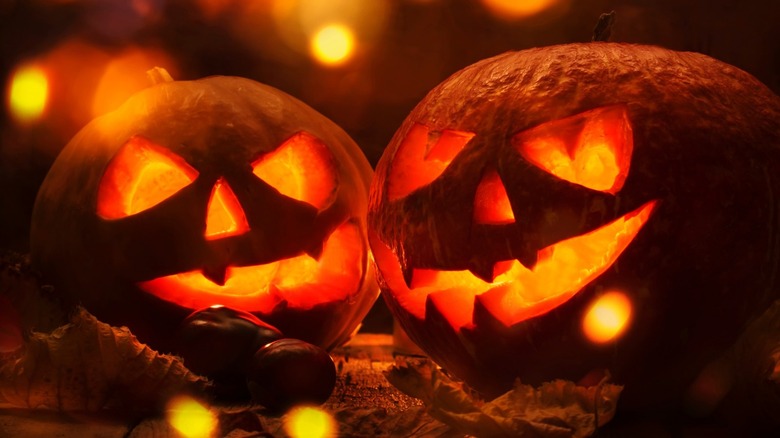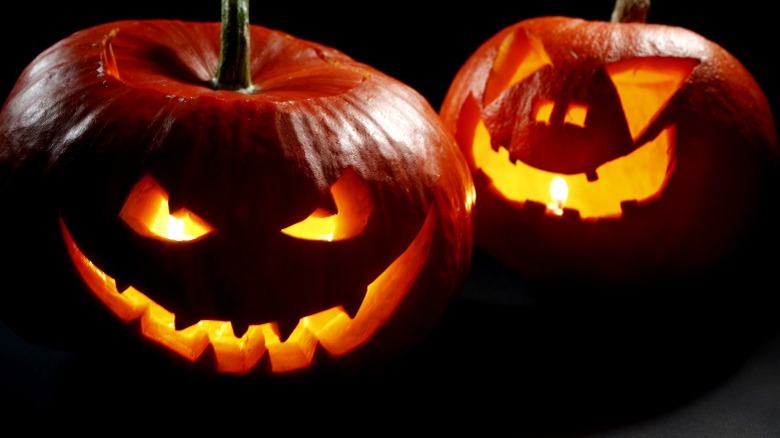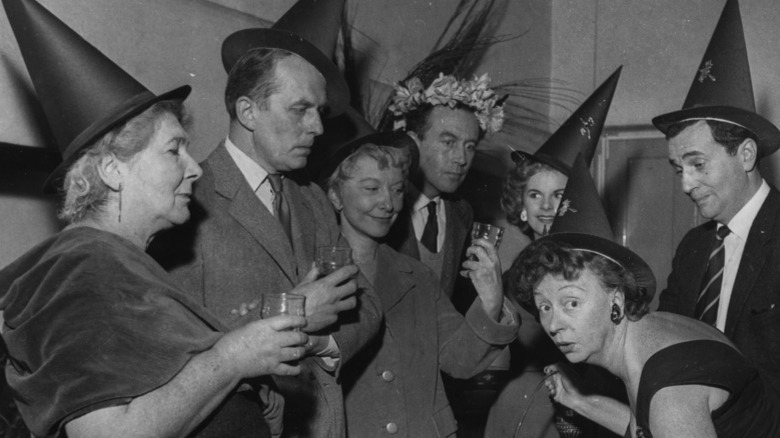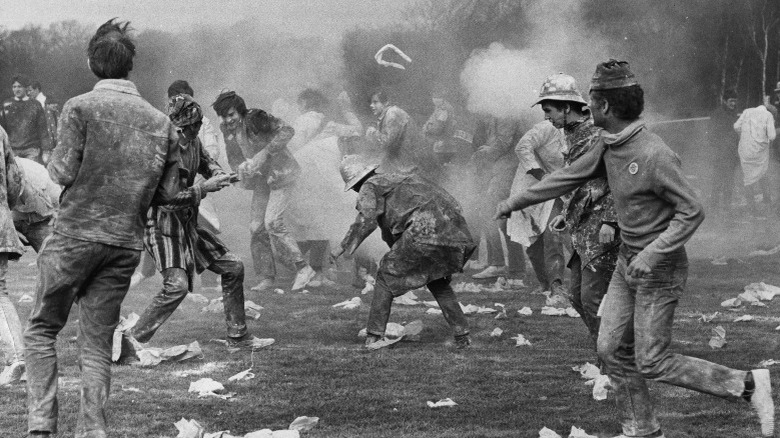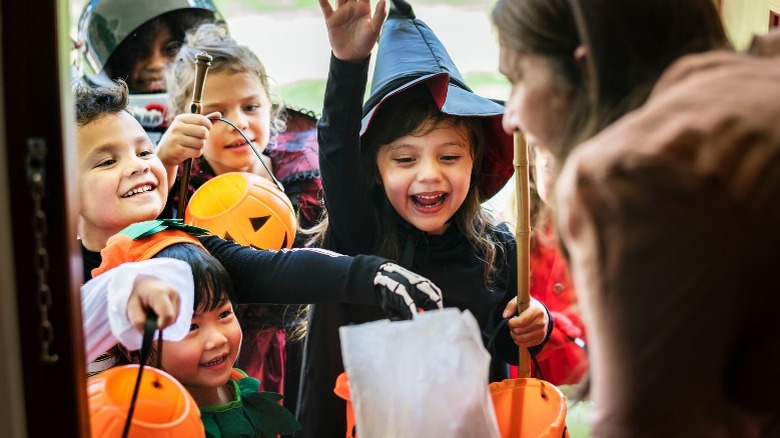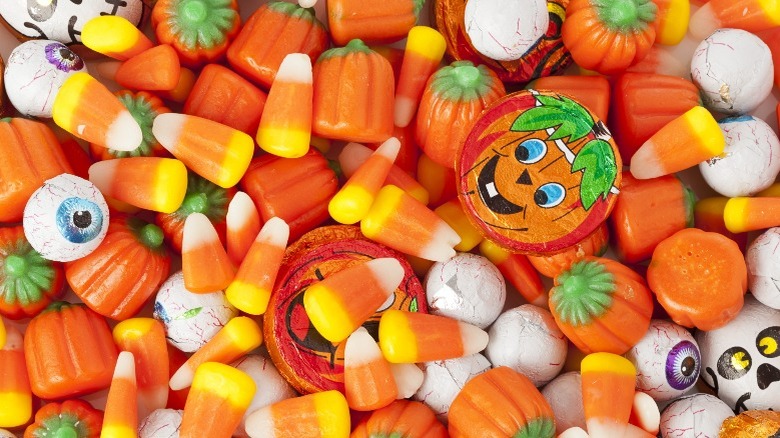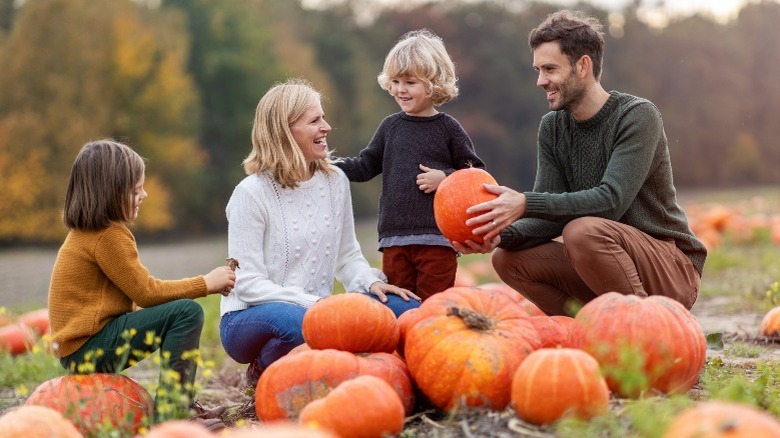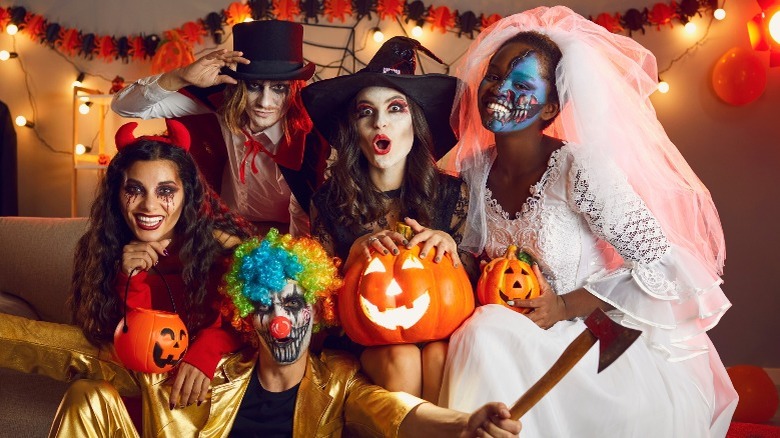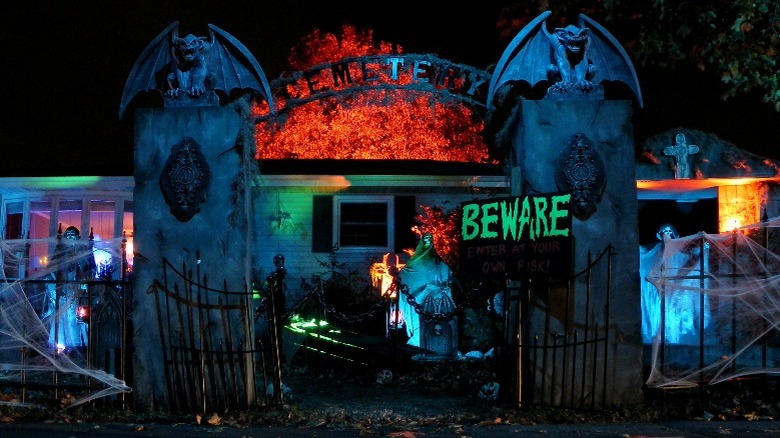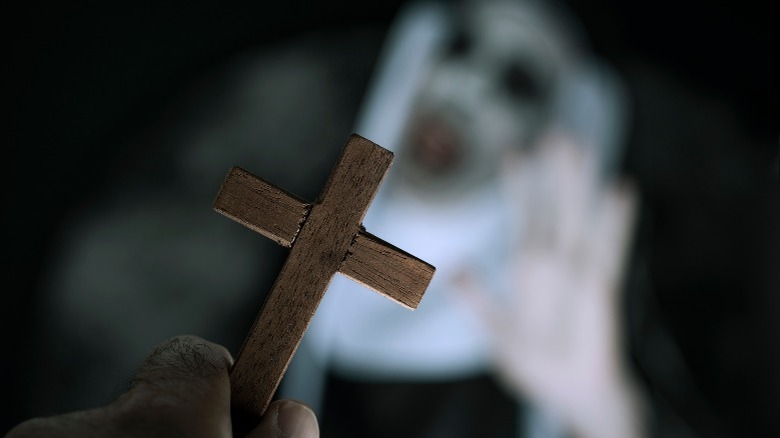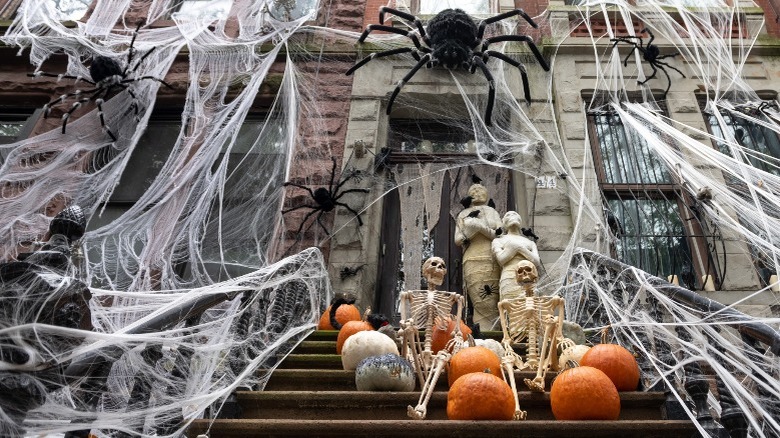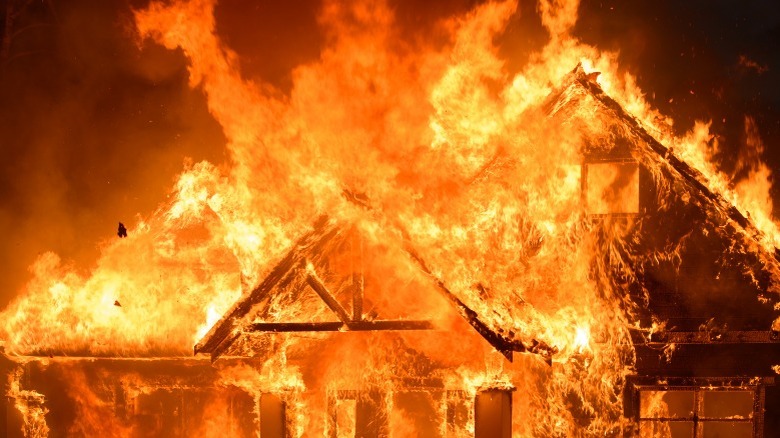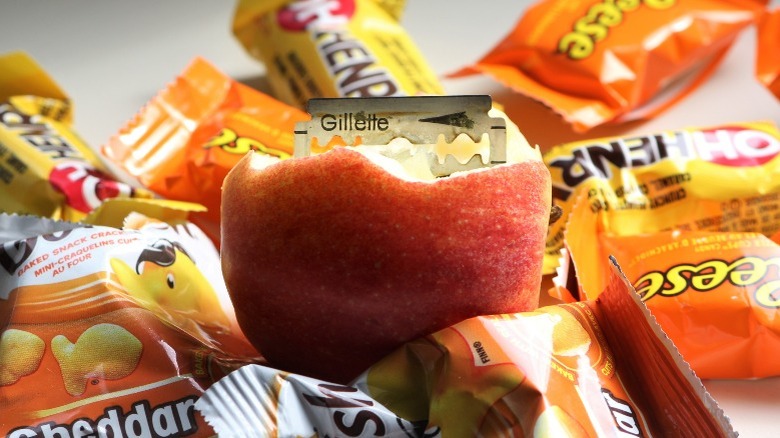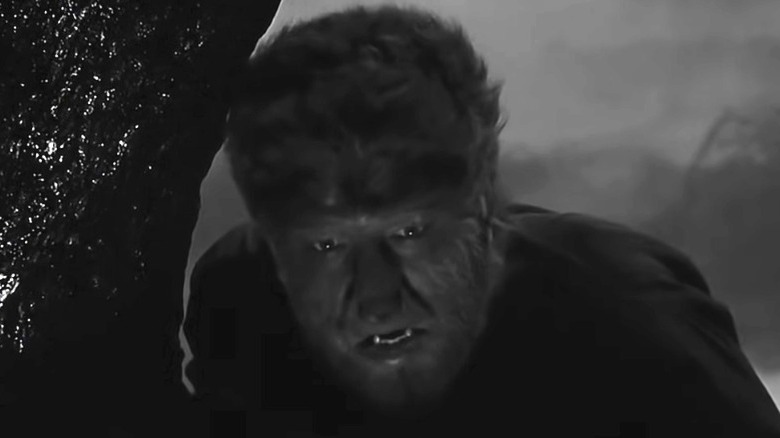What Halloween Was Like In 20th Century America
Like most things in America, Halloween is a patchwork quilt of cultures and traditions. As National Geographic notes, the holiday had already undergone several transformations before reaching the New World. It began as Samhain, a Celtic New Year's celebration that took place over 2,000 years ago on November 1.
The Celts believed that the boundary separating the realms of the living and dead was thinnest the night before Samhain — October 31 — and came up with a variety of traditions to avoid confrontations with spirits walking the Earth, including offering food and disguising themselves. According to a 1983 study published in Western Folklore, starting in the 7th century, Christian leaders rebranded the holiday to All Hallows' Day to stifle its pagan roots, but the traditional celebrations on its eve — deemed All Hallows' Eve or Hallowe'en — continued.
Halloween reached America by way of European immigrants — primarily Irish and Scottish individuals — in the 19th century. They brought their superstitions and traditions to the New World along with them, and, over the years, these merged with existing American agricultural practices to create the melting pot that is American Halloween. As with the original Celtic holiday, October 31 coincided with the completion of the harvest and the beginning of winter, so fall symbols like corn stalks, apples, scarecrows, and pumpkins also became associated with the celebration. The holiday quickly took on a life of its own, and to this day, no one does Halloween quite like America. Here is what Halloween was like in 20th-century America.
Carving jack-o'-lanterns became a yearly tradition
A grinning jack-o'-lantern glowing on a cool fall night is a sure sign of Halloween. According to National Geographic, the practice of hollowing out a vegetable, etching a face on it, and placing a lit candle inside originated thousands of years ago, when Celtic people used these primitive lanterns to hold vengeful spirits at bay on Samhain Eve.
Root vegetables — like beets, potatoes, and turnips — were the obvious choice, as they were abundant after the harvest. In fact, according to an 18th-century Irish folktale, the spirit of Stingy Jack — a seedy blacksmith who had tricked the devil and was banned from both heaven and hell — forever wanders the Earth with a turnip lantern lit by an ember, gifted to him by the devil himself. He was known as "Jack of the lantern," and vegetable lanterns everywhere became jack-o'-lanterns.
In the 19th century, Irish immigrants brought Stingy Jack to America. There, they found an even better material for lantern-making: pumpkins. The skin of the native orange gourd — conveniently harvested in the fall — was easier to carve and allowed for the creation of larger faces. As Lisa Morton notes in her book "Trick or Treat," pumpkins had been carved in America for years prior to Halloween's introduction, but the fusion of existing tradition and new legend — as well as an honorary mention in Washington Irving's "The Legend of Sleepy Hollow" — cemented the pumpkin jack-o'-lantern as a staple of American Halloween by the 20th century.
American Halloween was originally for adults
In the early 1900s, Halloween was mostly about fancy, themed parties for adults. According to David J. Skal in his book "Death Makes a Holiday," magazines of the time offered suggestions on how to throw the perfect Halloween party, including possible themes and decoration designs. And in 1912, the Dennison Manufacturing Company began offering paper décor like witch and black cat cut-outs and printed napkins to make the festivities easier. Per TCPalm, ambiance was created through dim lighting, glowing jack-o'-lanterns, and autumnal touches like fall leaves and corn husks.
Throwing the perfect party was an art form, and committing to a theme was essential. Common party themes included "Black Cat" and "Haunted House." Others were more focused and elaborate, such as the Egyptian-themed parties held around King Tut's discovery in the 1920s, which featured pyramid jack-o'-lanterns, gingerbread mummies, and puzzles to decipher (per "Death Makes a Holiday").
As Lisa Morton notes in her book "Trick or Treat," separate parties for children were held in the afternoon, keeping the night free for adult revelry. Unfortunately, Prohibition put a damper on the fun, and adult parties evaporated in the absence of liquor.
Halloween mischief was once rampant
American Halloween used to be more about tricks than treats. As Lisa Morton notes in her book "Trick or Treat," Halloween in Ireland was mostly about mischief, and this tradition quickly took root in early 20th-century America. On the night of October 31, boys everywhere enjoyed inflicting a number of pranks on their hapless neighbors. Jumping out and scaring people, ringing doorbells, throwing flour at men wearing black coats, rattling windowsills with wooden noisemakers called tick-tacks, making cabbage stink bombs, and stealing gates were mostly harmless shenanigans. Still, not everyone took kindly to them.
As The Topeka Daily Capital notes, a passerby tripped by a wire in Tucson, Arizona, was so angry he shot and killed one of the pranksters who strung it up in 1907. By the 1930s, adults had joined in, and the light-hearted mischief crossed over into all-out looting and vandalism (per "Trick or Treat").
During the Great Depression years, pranks included: flipping over cars, tripping people, breaking windows, toppling telephone poles, opening fire hydrants to release floods, teasing the police, and setting fires. The destruction was so bad on October 31, 1933, that it became known as Black Halloween, and many cities were considering banning the holiday altogether.
Trick-or-treating took off
Trick-or-treating — the American practice of dressing up in costumes and begging neighbors for delicacies — became widespread in 20th-century America (per National Geographic). But it was hardly a new concept. According to History, it likely has its roots in the practices of "souling" — in which people offered to pray for another's dead relatives in exchange for soul cakes — and "guising," in which costumed youths offered to sing or perform a trick in exchange for nuts, fruits, or coins.
Both Ireland and Scotland partook in these traditions, and immigrants from these countries introduced them to America. As Lisa Morton notes in her book "Trick or Treat," the Germanic-inspired Christmastime tradition of belsnickling — in which groups of costumed people journeyed door-to-door and begged for treats in exchange for tricks — was already in practice in the eastern United States and probably also inspired American trick-or-treating.
American communities first adopted organized trick-or-treating in the 1930s, likely as an attempt to curb destructive pranking (per History). According to Morton, World War II sugar rationing briefly limited the practice, as candy — the treat of choice — was less available. But in the 1950s, trick-or-treating exploded. Candy manufacturers got on board, costumes were mass-produced rather than sewn at home, and a post-war boom of suburban development created endless neighborhoods full of doorbells for kids to ring. The ritual was still going strong in America when the 20th century ended, although the trick component was lost — it had become all about costumes ... and candy.
Halloween candy became a billion-dollar industry
According to Lisa Morton in her book "Trick or Treat," nuts, apples, and homemade confections once counted as sweet rewards, but as trick-or-treating became an enterprise, "treat" became synonymous with manufactured candy. For one, it was much easier for adults to hand out. And for two, kids loved it. Naturally, it didn't take long for confectioners to jump on the money train.
Candy Corn became the first mass-produced Halloween candy — though, as National Geographic notes, it was originally called Chicken Feed and marketed to farmers in the 1880s. Already autumnally themed, Candy Corn rebranded itself as a Halloween candy and quickly became a mainstay of the holiday.
But what people really wanted was chocolate (per "Trick or Treat"). As CNN notes, chocolate was considered a luxury in the early 20th century until Hershey's, a Pennsylvania-based chocolate maker, started making their signature milk chocolate bars and Hershey's Kisses available to average Americans. Other leading manufacturers soon followed suit with Milky Way and Snickers bars, and by the 1950s, most candy makers were marketing their chocolates and other candies for Halloween. In 1999, at the 20th century's end, yearly Halloween candy sales had reached $1.896 billion (per Supermarket News).
Visiting a pumpkin patch became a rite of passage
Picking out the perfect pumpkin to carve for Halloween was not a decision to be made lightly. In fact, many Americans made a day out of the selection ritual. According to Cindy Ott in her book "Pumpkin," traveling to the country to pick a future jack-o'-lantern right off the vine first became popular after World War II and really took off in the 1970s and 1980s.
Farmers capitalized on the pumpkin craze, offering hot cider, live music, hay rides, and other bonuses to turn the day into a proper event. Pumpkin patches quickly developed into an important source of income for rural America. In some ways, pumpkin patches escalated Halloween to a major American holiday.
According to a 1983 study published in Western Folklore, the annual odyssey from more urban areas to the country was a symbolic way to get back to the roots of the holiday and connect to nature and the harvest. The process of journeying to a farm, selecting the perfect gourd, and bringing it home to decorate it is similar to the Christmas tree tradition, in which a piece of the natural world is brought into the home and ceremoniously altered.
The sky was the limit for costume inspiration
In the early 20th century, American Halloween costumes maintained their pagan roots of being ghoulish and scary. According to CNN, costumes in the early 1900s were meant to ward off evil spirits, make peace with death, and otherwise frighten. They were homemade and of simple construction, often a mishmash of makeup, masks, and bedsheets designed to completely disguise the wearer's identity. As time went on, disposable store-bought costumes became more available, and people started impersonating pirates and gypsies — although, as Insider notes, variety was lacking. After World War II, television changed the costume game forever.
Costumes became a direct reflection of popular culture trends — though, per Newsweek, ghosts, witches, cats, and devils remained perennial favorites. According to Insider, cowboys, Popeye, Tinkerbell, Mickey Mouse, and superheroes (per CNN) were widespread in the 1950s. In the '60s, The Addams Family and Barbie were big, Star Wars characters took over the '70s, and E.T. and gory figures dominated the '80s. The '90s, meanwhile, were all about brand-name products like McDonald's fries and Tootsie Rolls.
By the end of the 20th century, Halloween night was a hodgepodge of bloody corpses, princesses, scary clowns, superheroes, walking M&Ms, pirates, bedsheet ghosts, and adorable animals vying for candy or first prize in a costume contest.
Haunted houses and corn mazes were all the rage
Halloween attractions provided another great reason to get out of the house in October. As author Lisa Morton told Smithsonian Magazine, America's first haunted houses were constructed during the Great Depression as a way to distract kids from destructive pranking. Often, several houses would be involved, allowing for a tour of various spooky basement or attic scenes. The effects, of course, were simple and homemade. According to a 1937 party pamphlet directed at parents (via Lisa Morton's book "Trick or Treat"), an effective haunt could be devised using painted cardboard cats, with wet sponges and hanging hairnets for tactile stimulation, and staged actors moaning and wailing in the dark.
When Disneyland's Haunted Mansion opened in 1969, it pulled the concept out of basements and turned it into an institution. Unlike improvised home scenes, the Haunted Mansion's spooky effects were disturbingly realistic — and thrilling. Following its success, other theme parks quickly created their own haunted attractions, and, by the end of the century, smaller local haunted houses had become a Halloween mainstay.
For children too young to handle an intense scare, the corn maze provided wholesome autumn fun. According to National Geographic, the first American corn mazes opened in the mid-1990s, giving children and adults alike the chance to take a trip to the country and run through seemingly endless cornfields on a brisk fall night.
Some religious groups opposed Halloween
Not everyone in America was on board with Halloween's growing popularity. According to Time Magazine, many conservative evangelical Christians felt that the holiday promoted sexual promiscuity, temptation, and devil worship and was a sign that America was slipping deeper into moral depravity. They also believed that dabbling in the occult was dangerous and that taking part in Halloween festivities put people at risk of curses and demonic spirits. In the 1960s, such groups became more outspoken about their beliefs, even calling for Halloween celebrations to be banned from schools.
As David J. Skal notes in his book "Death Makes a Holiday," the anti-Halloween sentiments progressed further in the 1970s, when fundamentalist churches created their own versions of haunted house attractions called hell houses, which were billed as family-friendly entertainment. Only, instead of supernatural spooks and thrills, patrons were presented with elaborate and graphic scenes depicting blood-covered murder victims flipping the electric chair switch on their killers, funerals for people with AIDS to caution against homosexuality, and gruesome births in which crying girls were handed bloody animal entrails and admonished against abortion. Oddly enough, some also included simulated satanic sacrifices.
Spooky decorating began to rival Christmas
For the first half of the 20th century, Halloween decorating was a relatively simple affair. As Lisa Morton notes in her book "Trick or Treat," basic paper cut-outs, banners, window decals, pumpkins, and hay bales served as holiday décor. On occasion, tombstones, scarecrows, and hanging sheet ghosts were displayed to create spooky scenes. Most decorations were created at home using whatever was available. But as Halloween gained popularity in America, so did its decorations.
By the 1980s, the holiday was a full-blown commercial affair. Costumes and candy were already churned out in the fall, and it wasn't long before Halloween-specific decorations also became available at local supermarkets and drug stores. Adults started decorating their yards for the enjoyment of trick-or-treaters, and some even created elaborate walk-through displays that rivaled professional attractions.
In 1983, the first Spirit Halloween store opened, forever changing the decoration game. Though seasonal, Spirit was a store purely devoted to Halloween and its wares — a sure sign that the holiday was reaching Christmas-level popularity — and profits. Per CNN Money, Halloween decoration sales reached a whopping $2.5 billion in 1999.
Michigan was besieged with fires on Devil's Night
Some parts of the United States never stopped Halloween-related pranking. According to History, people living in the midwestern and eastern United States simply moved it to another night: October 30. Starting in the 1950s, the eve of All Hallows' Eve became known as Mischief Night, and the classic pranks of old returned along with the more modern additions of toilet-papering, egging, and soaping windows.
The destructive aspect of Halloween mischief also saw a resurgence in the 1970s and 1980s, when arsonists wreaked havoc on Michigan in the days leading up to Halloween, year after year. Hundreds of fires were set in trash cans, dumpsters, and even old abandoned buildings in the cities of Saginaw, Flint, and Detroit.
According to the CDC, 810 separate fires were reported in Detroit between October 29 and October 31 in 1984 — an event that became known as Devil's Night. Following the institution of a curfew and city watch, the number of fires decreased over the following years.
Poisoned candy allegations scared parents
Accepting candy from strangers wasn't without its hazards. According to Lisa Morton in her book "Trick or Treat," in 1964, a New York woman handed out steel wool, dog treats, and ant poison to trick-or-treaters she deemed too old. Urban legends about poisoned Halloween candy soon began to circulate — and the media fueled the fire. In the early 1970s, The New York Times implied that a child's trick-or-treat haul could include laxative chocolate bars, lye-laced bubblegum, and, most famously, apples with razor blades hidden inside.
According to CNN, the scare intensified in 1970, when a five-year-old boy died after exposure to heroin on Halloween night. The initial reports claimed the drug had been in his Halloween candy, spurring the social panic, though it was later revealed that he had found it elsewhere. Then, in 1974, another young boy died on Halloween after eating a cyanide-laced Pixie Stix — but it was his father, not a random stranger, who had poisoned his candy.
Still, rumors of a candyman killer made the rounds, trick-or-treating was banned in a few communities, and some hospitals even offered to X-ray candy. By 1982, candy sales had plummeted and 40 cities had banned Halloween (per CNN). But, according to a 1985 study published in Social Problems, no evidence of poisoned Halloween candy was ever found.
Halloween TV shows and movies got everyone in the spirit
As the nation became increasingly obsessed with television and cinema, it was only a matter of time before Halloween made its way to the big screen. As David J. Skal notes in his book "Death Makes a Holiday," Donald Duck and his nephews did it first. The cartoon special "Trick or Treat" aired in theaters throughout October 1952 and was later televised, heavily influencing Halloween traditions for many baby boomers. Per Vox, the iconic Peanuts TV special "It's the Great Pumpkin, Charlie Brown" continued the trend, first airing in 1966 and being televised religiously every year since.
Movies like 1931's "Frankenstein" and 1941's "The Wolfman" (pictured) were also released on television, inspiring a monster craze in the 1950s. According to Lisa Morton in her book "Trick or Treat," watching a monster movie after a night of trick-or-treating became a Halloween tradition for many.
Later, 1979's "Halloween" introduced the world to slasher films and became a gory phenomenon that continued through the '80s, and into the '90s, when the "Scream" franchise — and its ghost face masks — dominated Halloween (per "Death Makes a Holiday"). In addition, 1994's animated film "The Nightmare Before Christmas" earned $72 million in video rentals, further proving that Halloween had become a holiday beloved by kids and adults alike.
